Clinical case of a sexually transmitted infection Essay 2022
VerifiedAdded on 2022/10/18
|10
|2982
|7
Essay
AI Summary
Contribute Materials
Your contribution can guide someone’s learning journey. Share your
documents today.
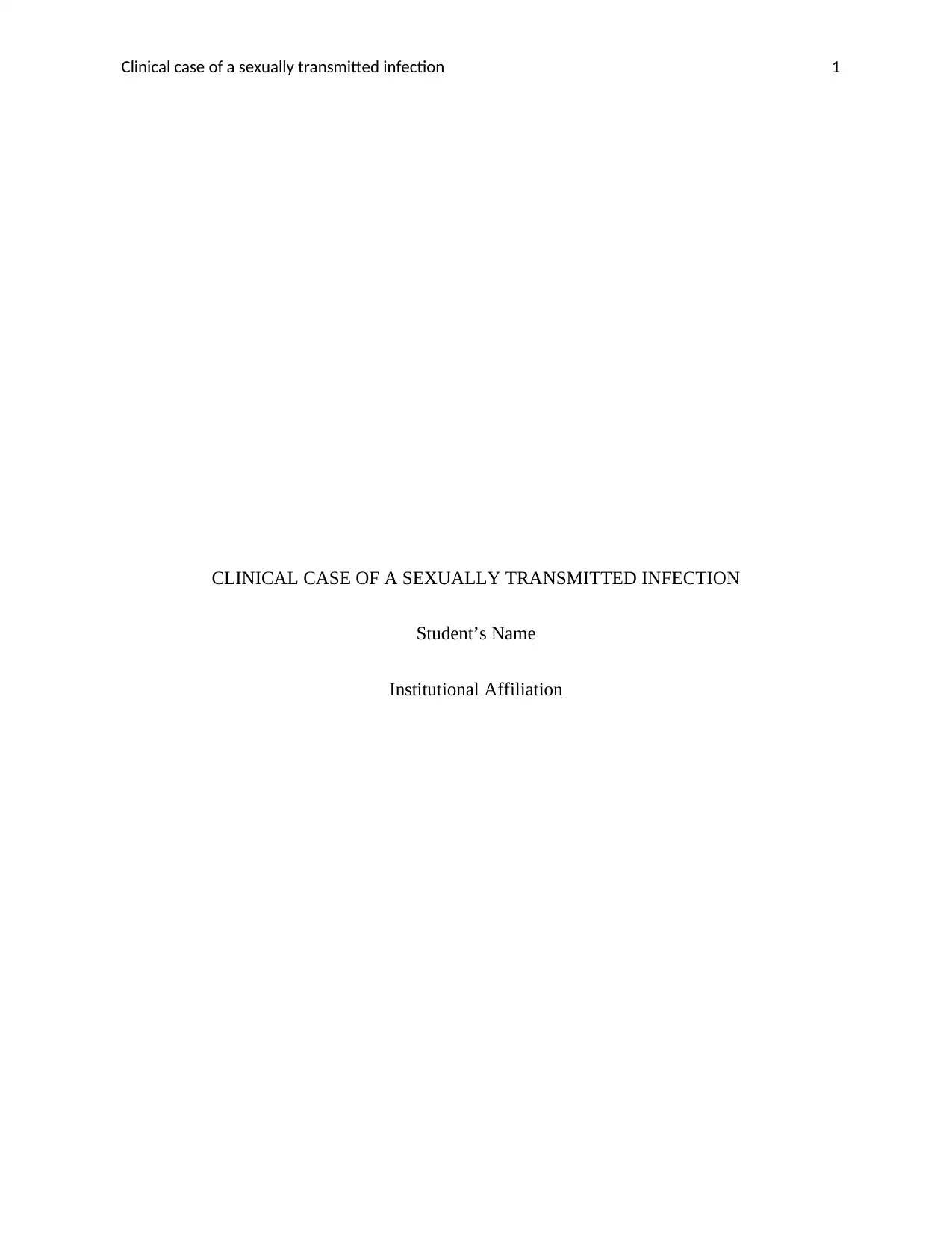
Clinical case of a sexually transmitted infection 1
CLINICAL CASE OF A SEXUALLY TRANSMITTED INFECTION
Student’s Name
Institutional Affiliation
CLINICAL CASE OF A SEXUALLY TRANSMITTED INFECTION
Student’s Name
Institutional Affiliation
Secure Best Marks with AI Grader
Need help grading? Try our AI Grader for instant feedback on your assignments.
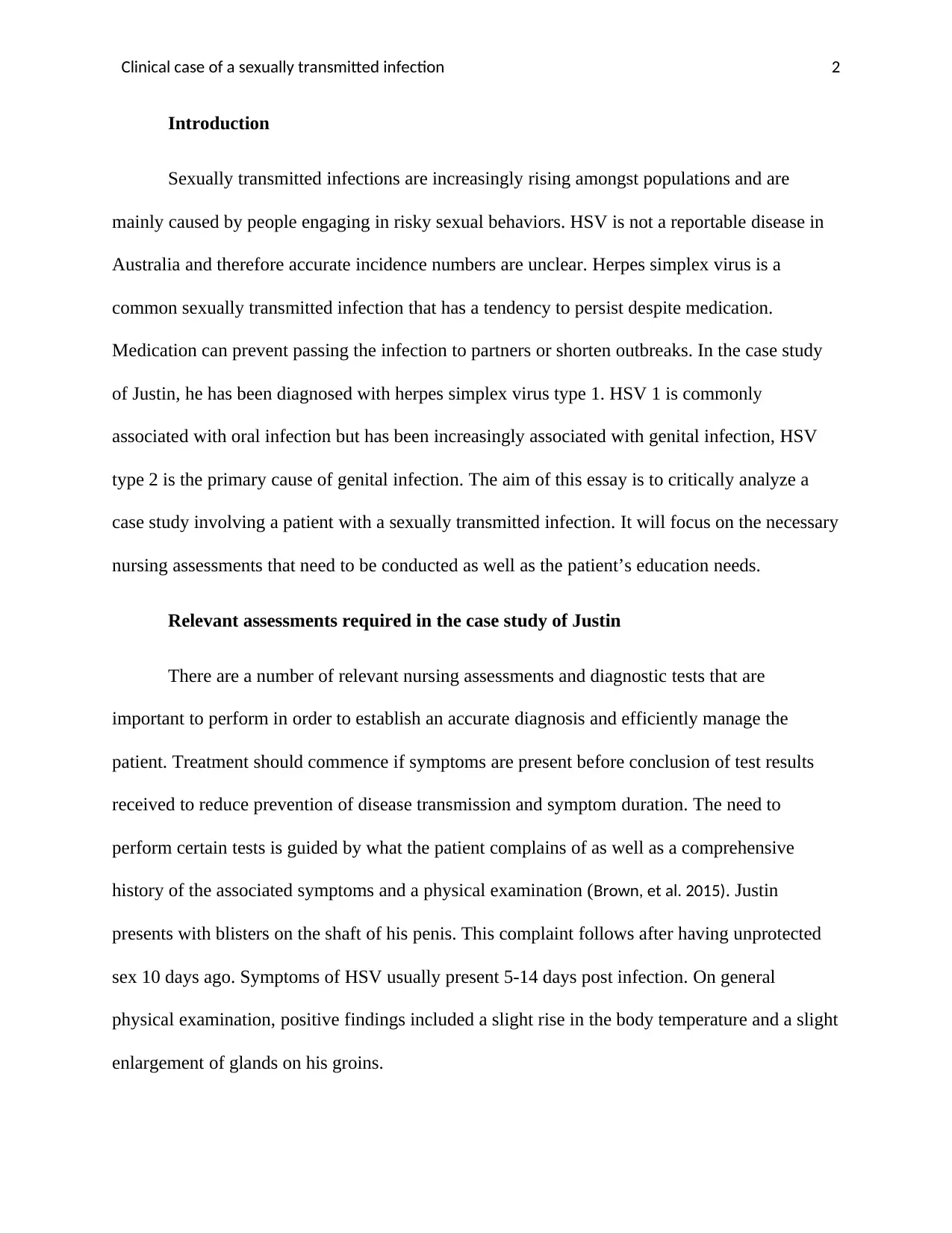
Clinical case of a sexually transmitted infection 2
Introduction
Sexually transmitted infections are increasingly rising amongst populations and are
mainly caused by people engaging in risky sexual behaviors. HSV is not a reportable disease in
Australia and therefore accurate incidence numbers are unclear. Herpes simplex virus is a
common sexually transmitted infection that has a tendency to persist despite medication.
Medication can prevent passing the infection to partners or shorten outbreaks. In the case study
of Justin, he has been diagnosed with herpes simplex virus type 1. HSV 1 is commonly
associated with oral infection but has been increasingly associated with genital infection, HSV
type 2 is the primary cause of genital infection. The aim of this essay is to critically analyze a
case study involving a patient with a sexually transmitted infection. It will focus on the necessary
nursing assessments that need to be conducted as well as the patient’s education needs.
Relevant assessments required in the case study of Justin
There are a number of relevant nursing assessments and diagnostic tests that are
important to perform in order to establish an accurate diagnosis and efficiently manage the
patient. Treatment should commence if symptoms are present before conclusion of test results
received to reduce prevention of disease transmission and symptom duration. The need to
perform certain tests is guided by what the patient complains of as well as a comprehensive
history of the associated symptoms and a physical examination (Brown, et al. 2015). Justin
presents with blisters on the shaft of his penis. This complaint follows after having unprotected
sex 10 days ago. Symptoms of HSV usually present 5-14 days post infection. On general
physical examination, positive findings included a slight rise in the body temperature and a slight
enlargement of glands on his groins.
Introduction
Sexually transmitted infections are increasingly rising amongst populations and are
mainly caused by people engaging in risky sexual behaviors. HSV is not a reportable disease in
Australia and therefore accurate incidence numbers are unclear. Herpes simplex virus is a
common sexually transmitted infection that has a tendency to persist despite medication.
Medication can prevent passing the infection to partners or shorten outbreaks. In the case study
of Justin, he has been diagnosed with herpes simplex virus type 1. HSV 1 is commonly
associated with oral infection but has been increasingly associated with genital infection, HSV
type 2 is the primary cause of genital infection. The aim of this essay is to critically analyze a
case study involving a patient with a sexually transmitted infection. It will focus on the necessary
nursing assessments that need to be conducted as well as the patient’s education needs.
Relevant assessments required in the case study of Justin
There are a number of relevant nursing assessments and diagnostic tests that are
important to perform in order to establish an accurate diagnosis and efficiently manage the
patient. Treatment should commence if symptoms are present before conclusion of test results
received to reduce prevention of disease transmission and symptom duration. The need to
perform certain tests is guided by what the patient complains of as well as a comprehensive
history of the associated symptoms and a physical examination (Brown, et al. 2015). Justin
presents with blisters on the shaft of his penis. This complaint follows after having unprotected
sex 10 days ago. Symptoms of HSV usually present 5-14 days post infection. On general
physical examination, positive findings included a slight rise in the body temperature and a slight
enlargement of glands on his groins.
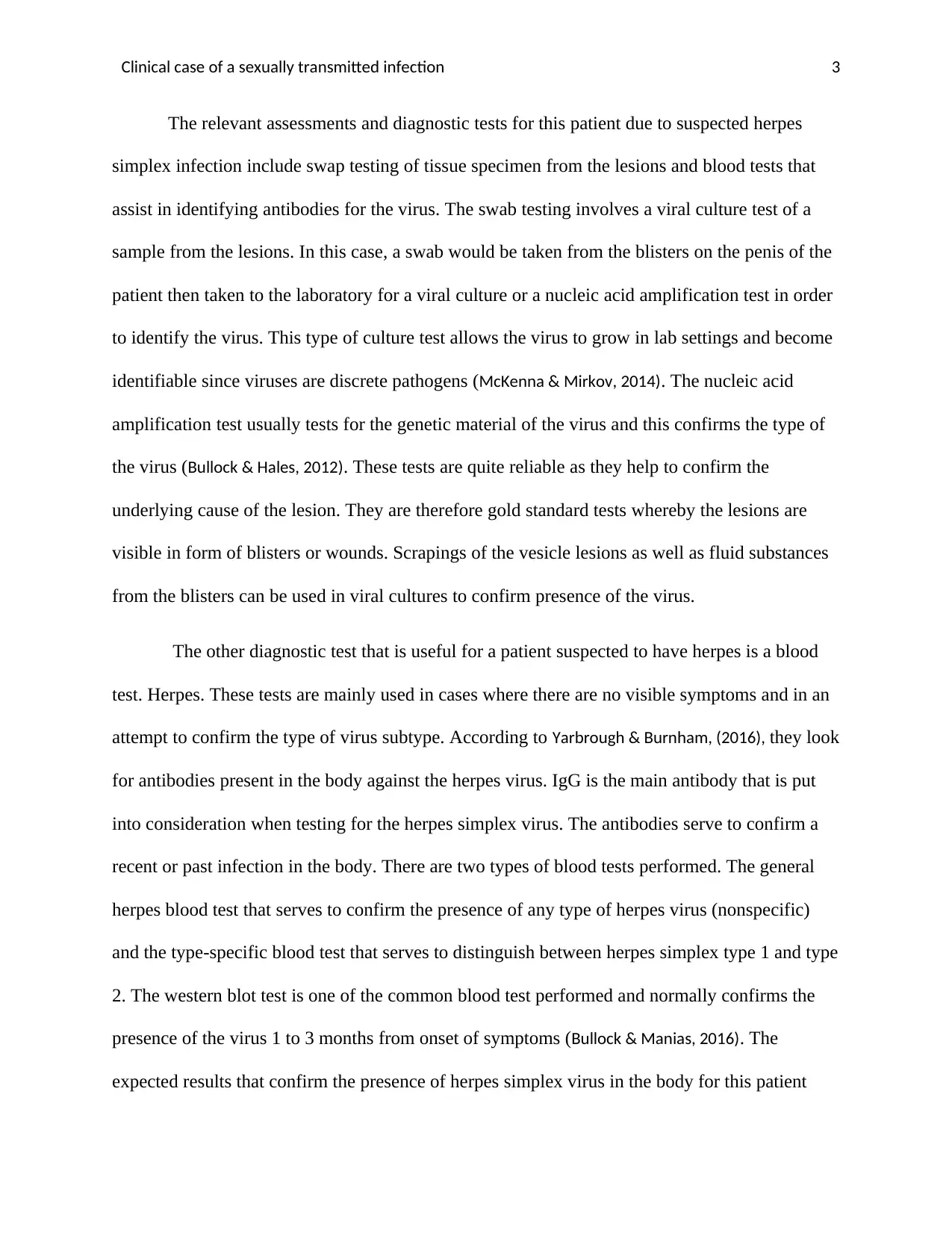
Clinical case of a sexually transmitted infection 3
The relevant assessments and diagnostic tests for this patient due to suspected herpes
simplex infection include swap testing of tissue specimen from the lesions and blood tests that
assist in identifying antibodies for the virus. The swab testing involves a viral culture test of a
sample from the lesions. In this case, a swab would be taken from the blisters on the penis of the
patient then taken to the laboratory for a viral culture or a nucleic acid amplification test in order
to identify the virus. This type of culture test allows the virus to grow in lab settings and become
identifiable since viruses are discrete pathogens (McKenna & Mirkov, 2014). The nucleic acid
amplification test usually tests for the genetic material of the virus and this confirms the type of
the virus (Bullock & Hales, 2012). These tests are quite reliable as they help to confirm the
underlying cause of the lesion. They are therefore gold standard tests whereby the lesions are
visible in form of blisters or wounds. Scrapings of the vesicle lesions as well as fluid substances
from the blisters can be used in viral cultures to confirm presence of the virus.
The other diagnostic test that is useful for a patient suspected to have herpes is a blood
test. Herpes. These tests are mainly used in cases where there are no visible symptoms and in an
attempt to confirm the type of virus subtype. According to Yarbrough & Burnham, (2016), they look
for antibodies present in the body against the herpes virus. IgG is the main antibody that is put
into consideration when testing for the herpes simplex virus. The antibodies serve to confirm a
recent or past infection in the body. There are two types of blood tests performed. The general
herpes blood test that serves to confirm the presence of any type of herpes virus (nonspecific)
and the type-specific blood test that serves to distinguish between herpes simplex type 1 and type
2. The western blot test is one of the common blood test performed and normally confirms the
presence of the virus 1 to 3 months from onset of symptoms (Bullock & Manias, 2016). The
expected results that confirm the presence of herpes simplex virus in the body for this patient
The relevant assessments and diagnostic tests for this patient due to suspected herpes
simplex infection include swap testing of tissue specimen from the lesions and blood tests that
assist in identifying antibodies for the virus. The swab testing involves a viral culture test of a
sample from the lesions. In this case, a swab would be taken from the blisters on the penis of the
patient then taken to the laboratory for a viral culture or a nucleic acid amplification test in order
to identify the virus. This type of culture test allows the virus to grow in lab settings and become
identifiable since viruses are discrete pathogens (McKenna & Mirkov, 2014). The nucleic acid
amplification test usually tests for the genetic material of the virus and this confirms the type of
the virus (Bullock & Hales, 2012). These tests are quite reliable as they help to confirm the
underlying cause of the lesion. They are therefore gold standard tests whereby the lesions are
visible in form of blisters or wounds. Scrapings of the vesicle lesions as well as fluid substances
from the blisters can be used in viral cultures to confirm presence of the virus.
The other diagnostic test that is useful for a patient suspected to have herpes is a blood
test. Herpes. These tests are mainly used in cases where there are no visible symptoms and in an
attempt to confirm the type of virus subtype. According to Yarbrough & Burnham, (2016), they look
for antibodies present in the body against the herpes virus. IgG is the main antibody that is put
into consideration when testing for the herpes simplex virus. The antibodies serve to confirm a
recent or past infection in the body. There are two types of blood tests performed. The general
herpes blood test that serves to confirm the presence of any type of herpes virus (nonspecific)
and the type-specific blood test that serves to distinguish between herpes simplex type 1 and type
2. The western blot test is one of the common blood test performed and normally confirms the
presence of the virus 1 to 3 months from onset of symptoms (Bullock & Manias, 2016). The
expected results that confirm the presence of herpes simplex virus in the body for this patient
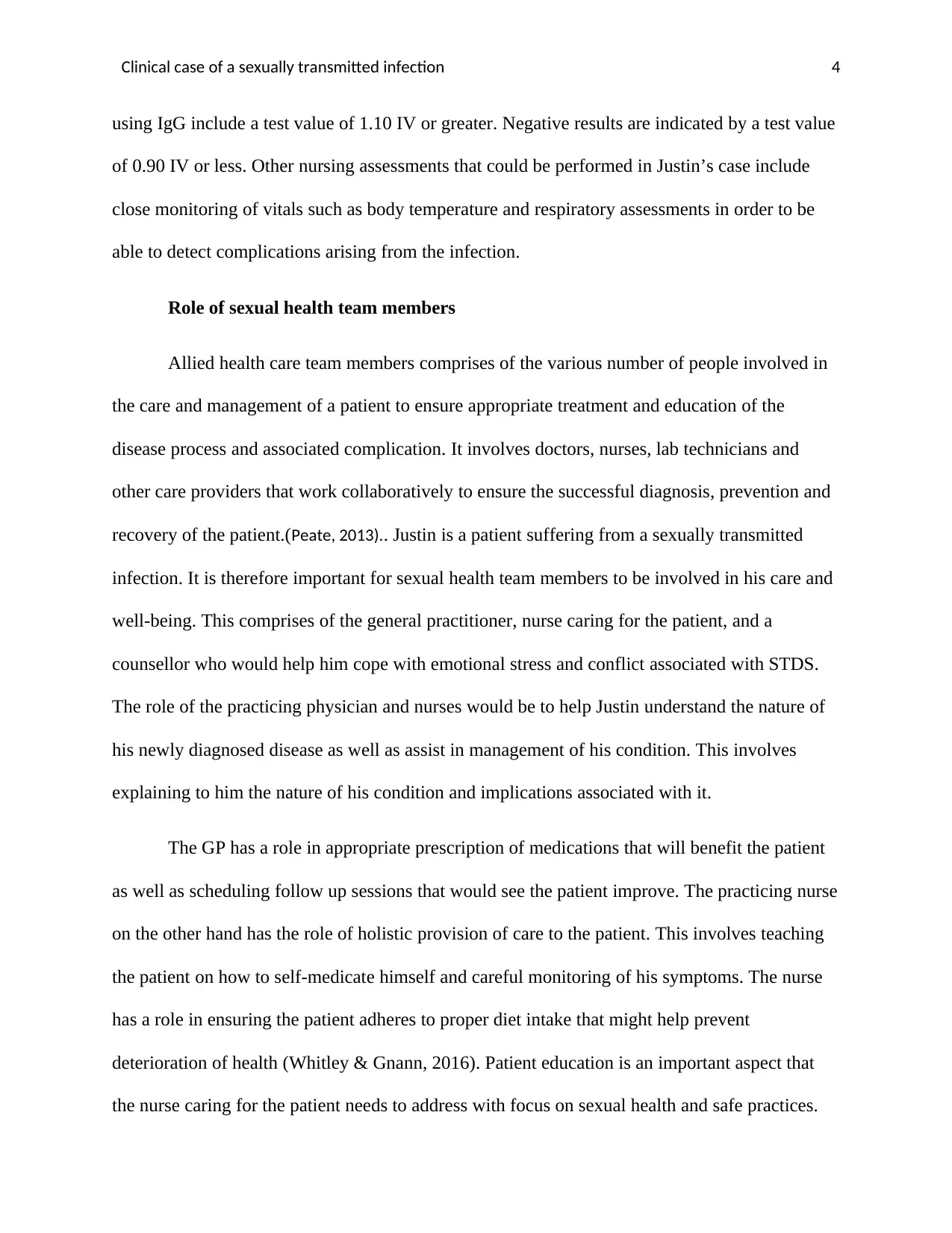
Clinical case of a sexually transmitted infection 4
using IgG include a test value of 1.10 IV or greater. Negative results are indicated by a test value
of 0.90 IV or less. Other nursing assessments that could be performed in Justin’s case include
close monitoring of vitals such as body temperature and respiratory assessments in order to be
able to detect complications arising from the infection.
Role of sexual health team members
Allied health care team members comprises of the various number of people involved in
the care and management of a patient to ensure appropriate treatment and education of the
disease process and associated complication. It involves doctors, nurses, lab technicians and
other care providers that work collaboratively to ensure the successful diagnosis, prevention and
recovery of the patient.(Peate, 2013).. Justin is a patient suffering from a sexually transmitted
infection. It is therefore important for sexual health team members to be involved in his care and
well-being. This comprises of the general practitioner, nurse caring for the patient, and a
counsellor who would help him cope with emotional stress and conflict associated with STDS.
The role of the practicing physician and nurses would be to help Justin understand the nature of
his newly diagnosed disease as well as assist in management of his condition. This involves
explaining to him the nature of his condition and implications associated with it.
The GP has a role in appropriate prescription of medications that will benefit the patient
as well as scheduling follow up sessions that would see the patient improve. The practicing nurse
on the other hand has the role of holistic provision of care to the patient. This involves teaching
the patient on how to self-medicate himself and careful monitoring of his symptoms. The nurse
has a role in ensuring the patient adheres to proper diet intake that might help prevent
deterioration of health (Whitley & Gnann, 2016). Patient education is an important aspect that
the nurse caring for the patient needs to address with focus on sexual health and safe practices.
using IgG include a test value of 1.10 IV or greater. Negative results are indicated by a test value
of 0.90 IV or less. Other nursing assessments that could be performed in Justin’s case include
close monitoring of vitals such as body temperature and respiratory assessments in order to be
able to detect complications arising from the infection.
Role of sexual health team members
Allied health care team members comprises of the various number of people involved in
the care and management of a patient to ensure appropriate treatment and education of the
disease process and associated complication. It involves doctors, nurses, lab technicians and
other care providers that work collaboratively to ensure the successful diagnosis, prevention and
recovery of the patient.(Peate, 2013).. Justin is a patient suffering from a sexually transmitted
infection. It is therefore important for sexual health team members to be involved in his care and
well-being. This comprises of the general practitioner, nurse caring for the patient, and a
counsellor who would help him cope with emotional stress and conflict associated with STDS.
The role of the practicing physician and nurses would be to help Justin understand the nature of
his newly diagnosed disease as well as assist in management of his condition. This involves
explaining to him the nature of his condition and implications associated with it.
The GP has a role in appropriate prescription of medications that will benefit the patient
as well as scheduling follow up sessions that would see the patient improve. The practicing nurse
on the other hand has the role of holistic provision of care to the patient. This involves teaching
the patient on how to self-medicate himself and careful monitoring of his symptoms. The nurse
has a role in ensuring the patient adheres to proper diet intake that might help prevent
deterioration of health (Whitley & Gnann, 2016). Patient education is an important aspect that
the nurse caring for the patient needs to address with focus on sexual health and safe practices.
Secure Best Marks with AI Grader
Need help grading? Try our AI Grader for instant feedback on your assignments.
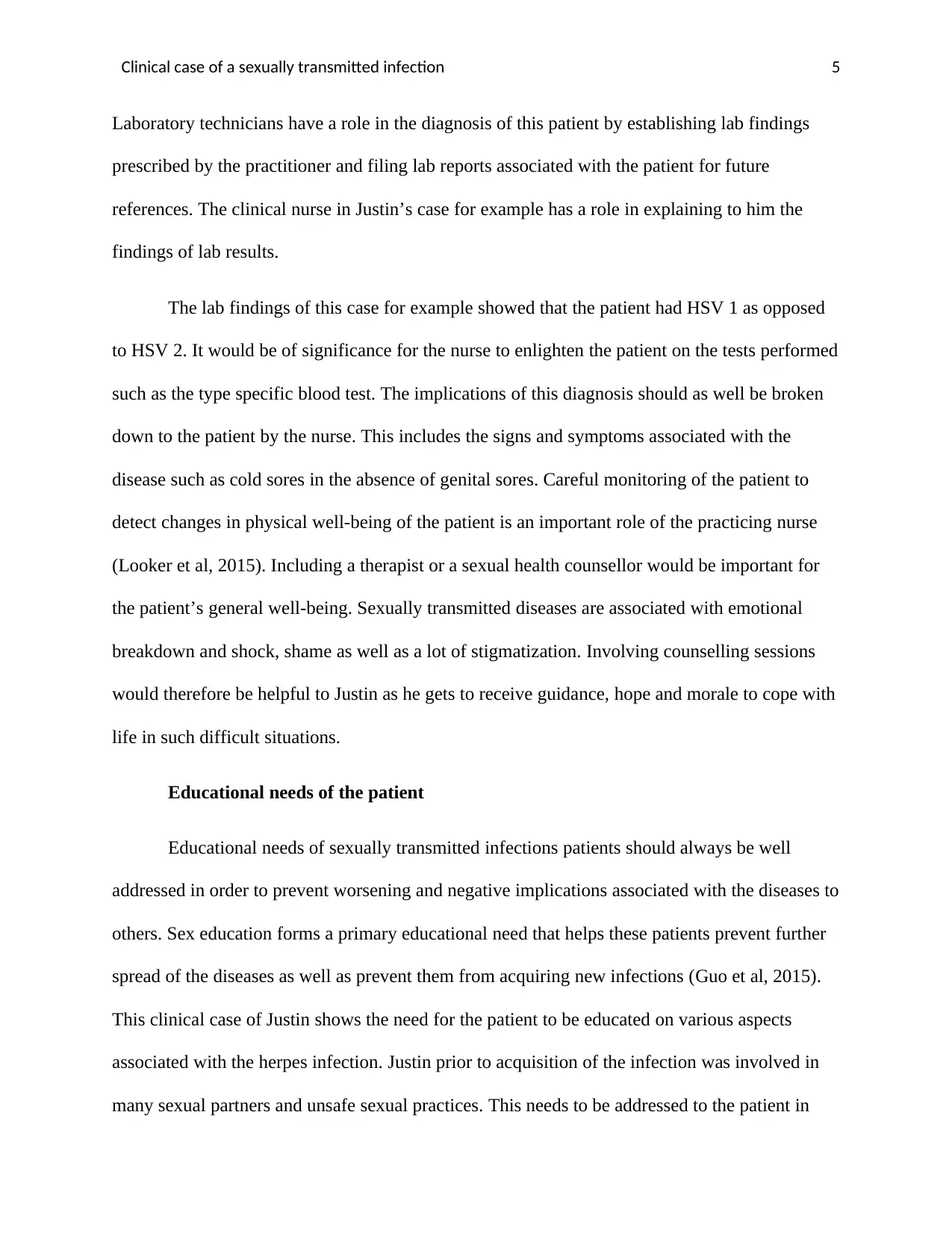
Clinical case of a sexually transmitted infection 5
Laboratory technicians have a role in the diagnosis of this patient by establishing lab findings
prescribed by the practitioner and filing lab reports associated with the patient for future
references. The clinical nurse in Justin’s case for example has a role in explaining to him the
findings of lab results.
The lab findings of this case for example showed that the patient had HSV 1 as opposed
to HSV 2. It would be of significance for the nurse to enlighten the patient on the tests performed
such as the type specific blood test. The implications of this diagnosis should as well be broken
down to the patient by the nurse. This includes the signs and symptoms associated with the
disease such as cold sores in the absence of genital sores. Careful monitoring of the patient to
detect changes in physical well-being of the patient is an important role of the practicing nurse
(Looker et al, 2015). Including a therapist or a sexual health counsellor would be important for
the patient’s general well-being. Sexually transmitted diseases are associated with emotional
breakdown and shock, shame as well as a lot of stigmatization. Involving counselling sessions
would therefore be helpful to Justin as he gets to receive guidance, hope and morale to cope with
life in such difficult situations.
Educational needs of the patient
Educational needs of sexually transmitted infections patients should always be well
addressed in order to prevent worsening and negative implications associated with the diseases to
others. Sex education forms a primary educational need that helps these patients prevent further
spread of the diseases as well as prevent them from acquiring new infections (Guo et al, 2015).
This clinical case of Justin shows the need for the patient to be educated on various aspects
associated with the herpes infection. Justin prior to acquisition of the infection was involved in
many sexual partners and unsafe sexual practices. This needs to be addressed to the patient in
Laboratory technicians have a role in the diagnosis of this patient by establishing lab findings
prescribed by the practitioner and filing lab reports associated with the patient for future
references. The clinical nurse in Justin’s case for example has a role in explaining to him the
findings of lab results.
The lab findings of this case for example showed that the patient had HSV 1 as opposed
to HSV 2. It would be of significance for the nurse to enlighten the patient on the tests performed
such as the type specific blood test. The implications of this diagnosis should as well be broken
down to the patient by the nurse. This includes the signs and symptoms associated with the
disease such as cold sores in the absence of genital sores. Careful monitoring of the patient to
detect changes in physical well-being of the patient is an important role of the practicing nurse
(Looker et al, 2015). Including a therapist or a sexual health counsellor would be important for
the patient’s general well-being. Sexually transmitted diseases are associated with emotional
breakdown and shock, shame as well as a lot of stigmatization. Involving counselling sessions
would therefore be helpful to Justin as he gets to receive guidance, hope and morale to cope with
life in such difficult situations.
Educational needs of the patient
Educational needs of sexually transmitted infections patients should always be well
addressed in order to prevent worsening and negative implications associated with the diseases to
others. Sex education forms a primary educational need that helps these patients prevent further
spread of the diseases as well as prevent them from acquiring new infections (Guo et al, 2015).
This clinical case of Justin shows the need for the patient to be educated on various aspects
associated with the herpes infection. Justin prior to acquisition of the infection was involved in
many sexual partners and unsafe sexual practices. This needs to be addressed to the patient in
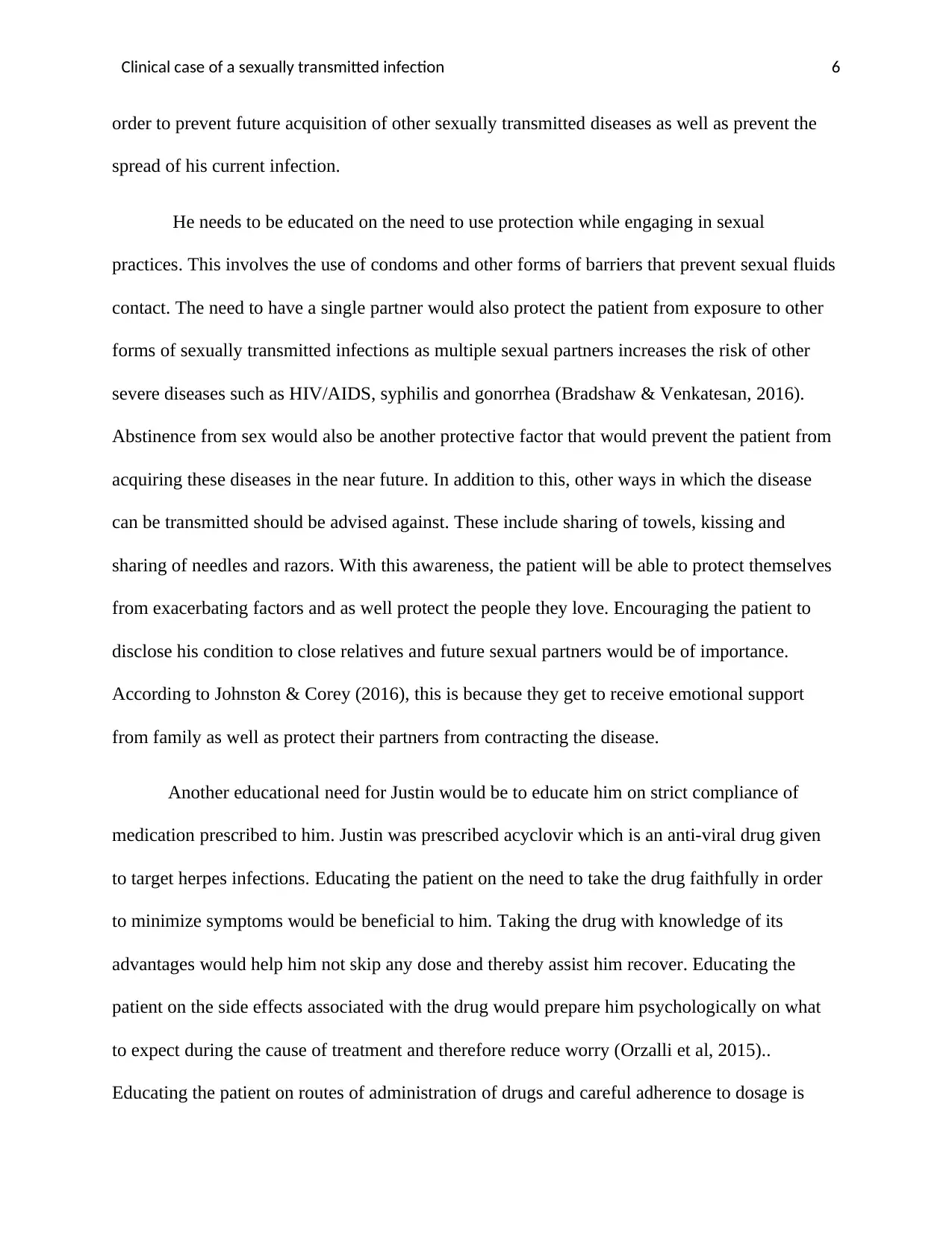
Clinical case of a sexually transmitted infection 6
order to prevent future acquisition of other sexually transmitted diseases as well as prevent the
spread of his current infection.
He needs to be educated on the need to use protection while engaging in sexual
practices. This involves the use of condoms and other forms of barriers that prevent sexual fluids
contact. The need to have a single partner would also protect the patient from exposure to other
forms of sexually transmitted infections as multiple sexual partners increases the risk of other
severe diseases such as HIV/AIDS, syphilis and gonorrhea (Bradshaw & Venkatesan, 2016).
Abstinence from sex would also be another protective factor that would prevent the patient from
acquiring these diseases in the near future. In addition to this, other ways in which the disease
can be transmitted should be advised against. These include sharing of towels, kissing and
sharing of needles and razors. With this awareness, the patient will be able to protect themselves
from exacerbating factors and as well protect the people they love. Encouraging the patient to
disclose his condition to close relatives and future sexual partners would be of importance.
According to Johnston & Corey (2016), this is because they get to receive emotional support
from family as well as protect their partners from contracting the disease.
Another educational need for Justin would be to educate him on strict compliance of
medication prescribed to him. Justin was prescribed acyclovir which is an anti-viral drug given
to target herpes infections. Educating the patient on the need to take the drug faithfully in order
to minimize symptoms would be beneficial to him. Taking the drug with knowledge of its
advantages would help him not skip any dose and thereby assist him recover. Educating the
patient on the side effects associated with the drug would prepare him psychologically on what
to expect during the cause of treatment and therefore reduce worry (Orzalli et al, 2015)..
Educating the patient on routes of administration of drugs and careful adherence to dosage is
order to prevent future acquisition of other sexually transmitted diseases as well as prevent the
spread of his current infection.
He needs to be educated on the need to use protection while engaging in sexual
practices. This involves the use of condoms and other forms of barriers that prevent sexual fluids
contact. The need to have a single partner would also protect the patient from exposure to other
forms of sexually transmitted infections as multiple sexual partners increases the risk of other
severe diseases such as HIV/AIDS, syphilis and gonorrhea (Bradshaw & Venkatesan, 2016).
Abstinence from sex would also be another protective factor that would prevent the patient from
acquiring these diseases in the near future. In addition to this, other ways in which the disease
can be transmitted should be advised against. These include sharing of towels, kissing and
sharing of needles and razors. With this awareness, the patient will be able to protect themselves
from exacerbating factors and as well protect the people they love. Encouraging the patient to
disclose his condition to close relatives and future sexual partners would be of importance.
According to Johnston & Corey (2016), this is because they get to receive emotional support
from family as well as protect their partners from contracting the disease.
Another educational need for Justin would be to educate him on strict compliance of
medication prescribed to him. Justin was prescribed acyclovir which is an anti-viral drug given
to target herpes infections. Educating the patient on the need to take the drug faithfully in order
to minimize symptoms would be beneficial to him. Taking the drug with knowledge of its
advantages would help him not skip any dose and thereby assist him recover. Educating the
patient on the side effects associated with the drug would prepare him psychologically on what
to expect during the cause of treatment and therefore reduce worry (Orzalli et al, 2015)..
Educating the patient on routes of administration of drugs and careful adherence to dosage is
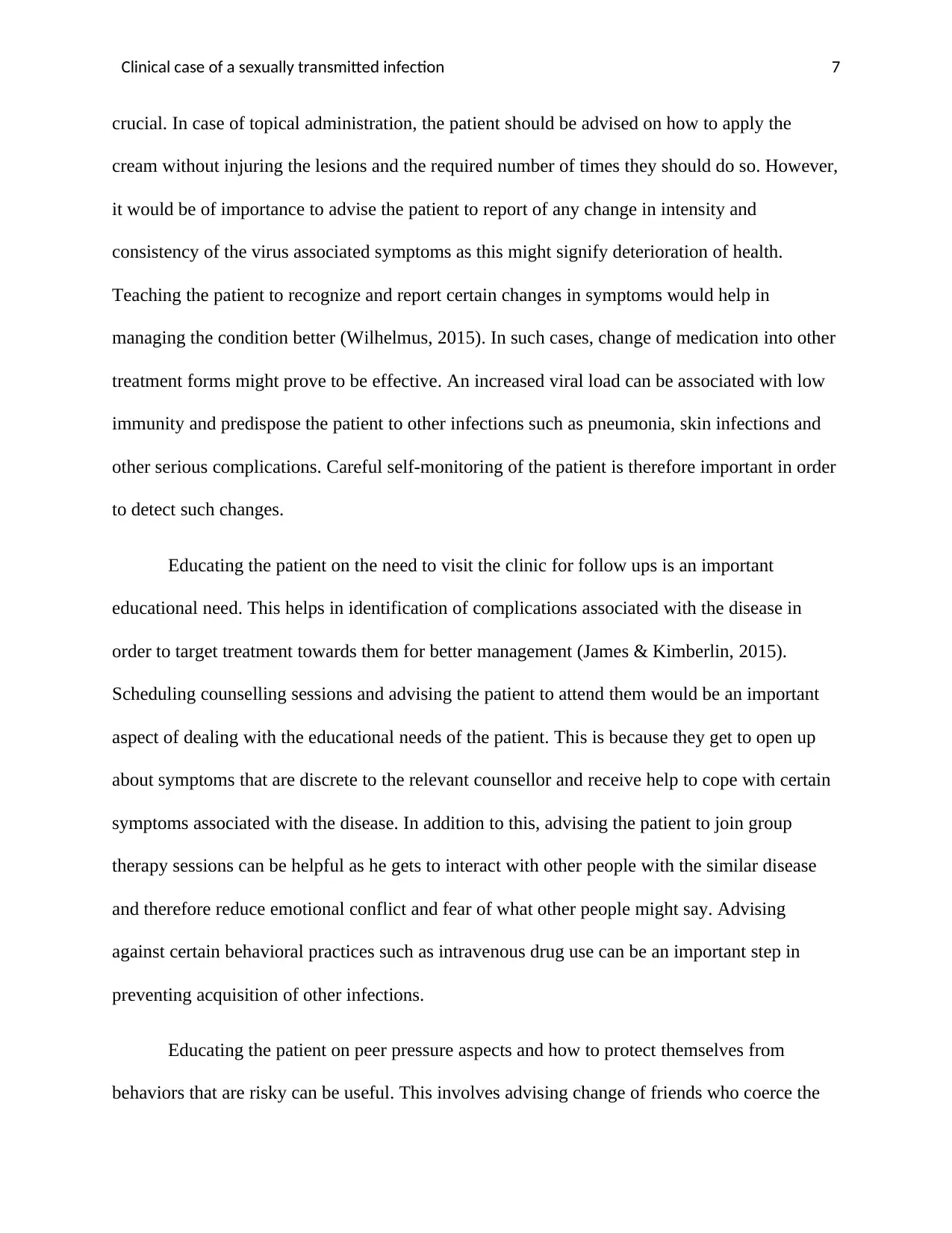
Clinical case of a sexually transmitted infection 7
crucial. In case of topical administration, the patient should be advised on how to apply the
cream without injuring the lesions and the required number of times they should do so. However,
it would be of importance to advise the patient to report of any change in intensity and
consistency of the virus associated symptoms as this might signify deterioration of health.
Teaching the patient to recognize and report certain changes in symptoms would help in
managing the condition better (Wilhelmus, 2015). In such cases, change of medication into other
treatment forms might prove to be effective. An increased viral load can be associated with low
immunity and predispose the patient to other infections such as pneumonia, skin infections and
other serious complications. Careful self-monitoring of the patient is therefore important in order
to detect such changes.
Educating the patient on the need to visit the clinic for follow ups is an important
educational need. This helps in identification of complications associated with the disease in
order to target treatment towards them for better management (James & Kimberlin, 2015).
Scheduling counselling sessions and advising the patient to attend them would be an important
aspect of dealing with the educational needs of the patient. This is because they get to open up
about symptoms that are discrete to the relevant counsellor and receive help to cope with certain
symptoms associated with the disease. In addition to this, advising the patient to join group
therapy sessions can be helpful as he gets to interact with other people with the similar disease
and therefore reduce emotional conflict and fear of what other people might say. Advising
against certain behavioral practices such as intravenous drug use can be an important step in
preventing acquisition of other infections.
Educating the patient on peer pressure aspects and how to protect themselves from
behaviors that are risky can be useful. This involves advising change of friends who coerce the
crucial. In case of topical administration, the patient should be advised on how to apply the
cream without injuring the lesions and the required number of times they should do so. However,
it would be of importance to advise the patient to report of any change in intensity and
consistency of the virus associated symptoms as this might signify deterioration of health.
Teaching the patient to recognize and report certain changes in symptoms would help in
managing the condition better (Wilhelmus, 2015). In such cases, change of medication into other
treatment forms might prove to be effective. An increased viral load can be associated with low
immunity and predispose the patient to other infections such as pneumonia, skin infections and
other serious complications. Careful self-monitoring of the patient is therefore important in order
to detect such changes.
Educating the patient on the need to visit the clinic for follow ups is an important
educational need. This helps in identification of complications associated with the disease in
order to target treatment towards them for better management (James & Kimberlin, 2015).
Scheduling counselling sessions and advising the patient to attend them would be an important
aspect of dealing with the educational needs of the patient. This is because they get to open up
about symptoms that are discrete to the relevant counsellor and receive help to cope with certain
symptoms associated with the disease. In addition to this, advising the patient to join group
therapy sessions can be helpful as he gets to interact with other people with the similar disease
and therefore reduce emotional conflict and fear of what other people might say. Advising
against certain behavioral practices such as intravenous drug use can be an important step in
preventing acquisition of other infections.
Educating the patient on peer pressure aspects and how to protect themselves from
behaviors that are risky can be useful. This involves advising change of friends who coerce the
Paraphrase This Document
Need a fresh take? Get an instant paraphrase of this document with our AI Paraphraser
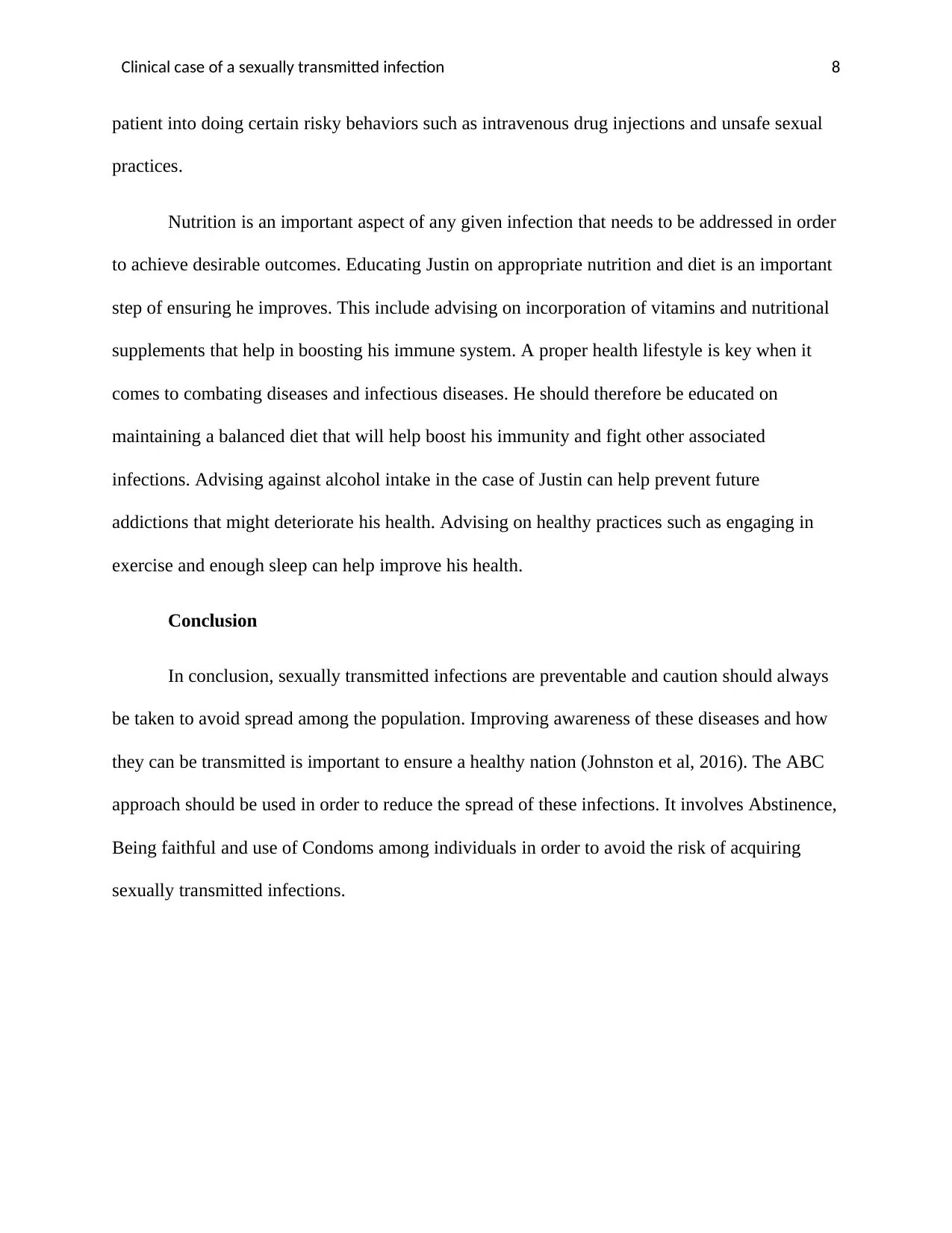
Clinical case of a sexually transmitted infection 8
patient into doing certain risky behaviors such as intravenous drug injections and unsafe sexual
practices.
Nutrition is an important aspect of any given infection that needs to be addressed in order
to achieve desirable outcomes. Educating Justin on appropriate nutrition and diet is an important
step of ensuring he improves. This include advising on incorporation of vitamins and nutritional
supplements that help in boosting his immune system. A proper health lifestyle is key when it
comes to combating diseases and infectious diseases. He should therefore be educated on
maintaining a balanced diet that will help boost his immunity and fight other associated
infections. Advising against alcohol intake in the case of Justin can help prevent future
addictions that might deteriorate his health. Advising on healthy practices such as engaging in
exercise and enough sleep can help improve his health.
Conclusion
In conclusion, sexually transmitted infections are preventable and caution should always
be taken to avoid spread among the population. Improving awareness of these diseases and how
they can be transmitted is important to ensure a healthy nation (Johnston et al, 2016). The ABC
approach should be used in order to reduce the spread of these infections. It involves Abstinence,
Being faithful and use of Condoms among individuals in order to avoid the risk of acquiring
sexually transmitted infections.
patient into doing certain risky behaviors such as intravenous drug injections and unsafe sexual
practices.
Nutrition is an important aspect of any given infection that needs to be addressed in order
to achieve desirable outcomes. Educating Justin on appropriate nutrition and diet is an important
step of ensuring he improves. This include advising on incorporation of vitamins and nutritional
supplements that help in boosting his immune system. A proper health lifestyle is key when it
comes to combating diseases and infectious diseases. He should therefore be educated on
maintaining a balanced diet that will help boost his immunity and fight other associated
infections. Advising against alcohol intake in the case of Justin can help prevent future
addictions that might deteriorate his health. Advising on healthy practices such as engaging in
exercise and enough sleep can help improve his health.
Conclusion
In conclusion, sexually transmitted infections are preventable and caution should always
be taken to avoid spread among the population. Improving awareness of these diseases and how
they can be transmitted is important to ensure a healthy nation (Johnston et al, 2016). The ABC
approach should be used in order to reduce the spread of these infections. It involves Abstinence,
Being faithful and use of Condoms among individuals in order to avoid the risk of acquiring
sexually transmitted infections.
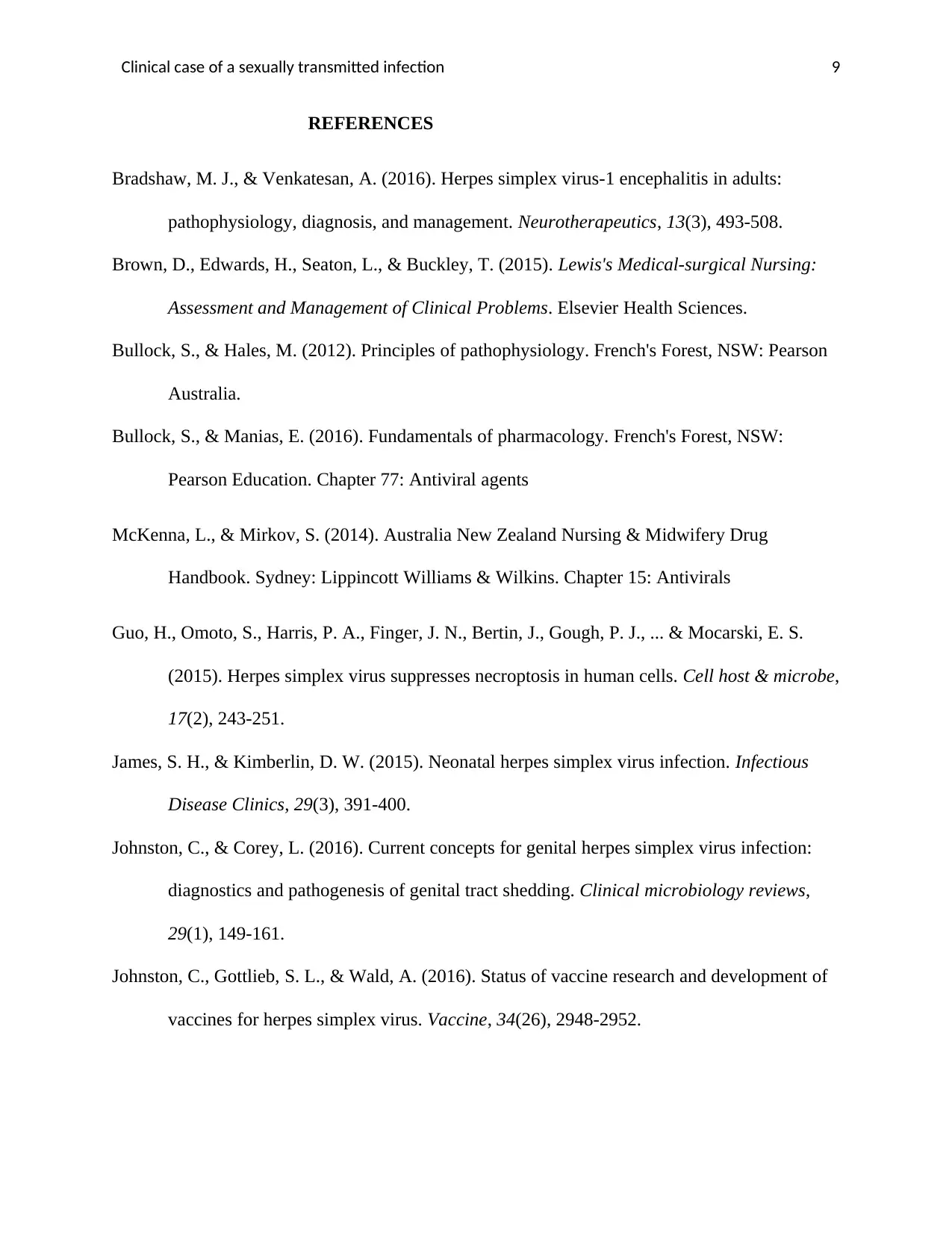
Clinical case of a sexually transmitted infection 9
REFERENCES
Bradshaw, M. J., & Venkatesan, A. (2016). Herpes simplex virus-1 encephalitis in adults:
pathophysiology, diagnosis, and management. Neurotherapeutics, 13(3), 493-508.
Brown, D., Edwards, H., Seaton, L., & Buckley, T. (2015). Lewis's Medical-surgical Nursing:
Assessment and Management of Clinical Problems. Elsevier Health Sciences.
Bullock, S., & Hales, M. (2012). Principles of pathophysiology. French's Forest, NSW: Pearson
Australia.
Bullock, S., & Manias, E. (2016). Fundamentals of pharmacology. French's Forest, NSW:
Pearson Education. Chapter 77: Antiviral agents
McKenna, L., & Mirkov, S. (2014). Australia New Zealand Nursing & Midwifery Drug
Handbook. Sydney: Lippincott Williams & Wilkins. Chapter 15: Antivirals
Guo, H., Omoto, S., Harris, P. A., Finger, J. N., Bertin, J., Gough, P. J., ... & Mocarski, E. S.
(2015). Herpes simplex virus suppresses necroptosis in human cells. Cell host & microbe,
17(2), 243-251.
James, S. H., & Kimberlin, D. W. (2015). Neonatal herpes simplex virus infection. Infectious
Disease Clinics, 29(3), 391-400.
Johnston, C., & Corey, L. (2016). Current concepts for genital herpes simplex virus infection:
diagnostics and pathogenesis of genital tract shedding. Clinical microbiology reviews,
29(1), 149-161.
Johnston, C., Gottlieb, S. L., & Wald, A. (2016). Status of vaccine research and development of
vaccines for herpes simplex virus. Vaccine, 34(26), 2948-2952.
REFERENCES
Bradshaw, M. J., & Venkatesan, A. (2016). Herpes simplex virus-1 encephalitis in adults:
pathophysiology, diagnosis, and management. Neurotherapeutics, 13(3), 493-508.
Brown, D., Edwards, H., Seaton, L., & Buckley, T. (2015). Lewis's Medical-surgical Nursing:
Assessment and Management of Clinical Problems. Elsevier Health Sciences.
Bullock, S., & Hales, M. (2012). Principles of pathophysiology. French's Forest, NSW: Pearson
Australia.
Bullock, S., & Manias, E. (2016). Fundamentals of pharmacology. French's Forest, NSW:
Pearson Education. Chapter 77: Antiviral agents
McKenna, L., & Mirkov, S. (2014). Australia New Zealand Nursing & Midwifery Drug
Handbook. Sydney: Lippincott Williams & Wilkins. Chapter 15: Antivirals
Guo, H., Omoto, S., Harris, P. A., Finger, J. N., Bertin, J., Gough, P. J., ... & Mocarski, E. S.
(2015). Herpes simplex virus suppresses necroptosis in human cells. Cell host & microbe,
17(2), 243-251.
James, S. H., & Kimberlin, D. W. (2015). Neonatal herpes simplex virus infection. Infectious
Disease Clinics, 29(3), 391-400.
Johnston, C., & Corey, L. (2016). Current concepts for genital herpes simplex virus infection:
diagnostics and pathogenesis of genital tract shedding. Clinical microbiology reviews,
29(1), 149-161.
Johnston, C., Gottlieb, S. L., & Wald, A. (2016). Status of vaccine research and development of
vaccines for herpes simplex virus. Vaccine, 34(26), 2948-2952.
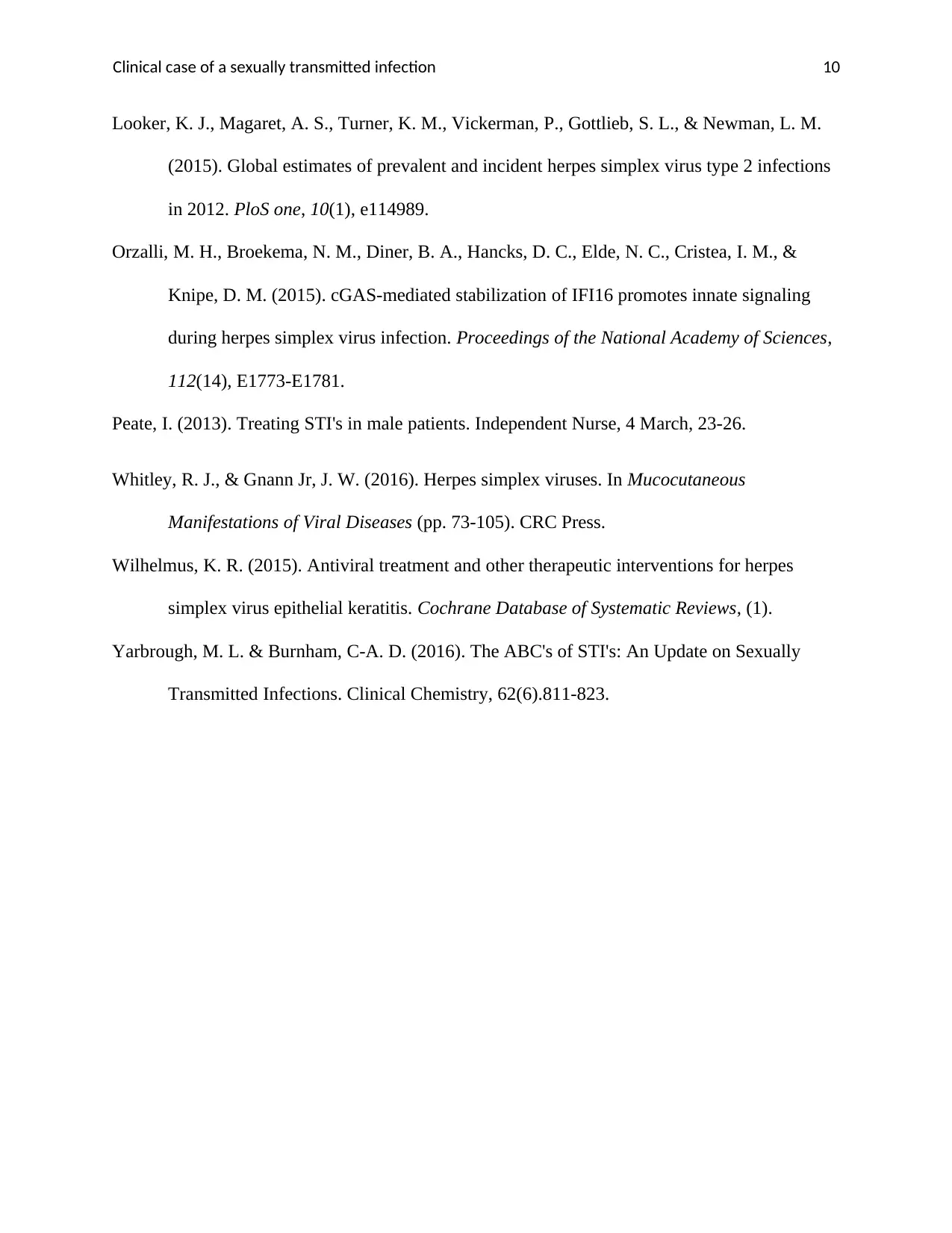
Clinical case of a sexually transmitted infection 10
Looker, K. J., Magaret, A. S., Turner, K. M., Vickerman, P., Gottlieb, S. L., & Newman, L. M.
(2015). Global estimates of prevalent and incident herpes simplex virus type 2 infections
in 2012. PloS one, 10(1), e114989.
Orzalli, M. H., Broekema, N. M., Diner, B. A., Hancks, D. C., Elde, N. C., Cristea, I. M., &
Knipe, D. M. (2015). cGAS-mediated stabilization of IFI16 promotes innate signaling
during herpes simplex virus infection. Proceedings of the National Academy of Sciences,
112(14), E1773-E1781.
Peate, I. (2013). Treating STI's in male patients. Independent Nurse, 4 March, 23-26.
Whitley, R. J., & Gnann Jr, J. W. (2016). Herpes simplex viruses. In Mucocutaneous
Manifestations of Viral Diseases (pp. 73-105). CRC Press.
Wilhelmus, K. R. (2015). Antiviral treatment and other therapeutic interventions for herpes
simplex virus epithelial keratitis. Cochrane Database of Systematic Reviews, (1).
Yarbrough, M. L. & Burnham, C-A. D. (2016). The ABC's of STI's: An Update on Sexually
Transmitted Infections. Clinical Chemistry, 62(6).811-823.
Looker, K. J., Magaret, A. S., Turner, K. M., Vickerman, P., Gottlieb, S. L., & Newman, L. M.
(2015). Global estimates of prevalent and incident herpes simplex virus type 2 infections
in 2012. PloS one, 10(1), e114989.
Orzalli, M. H., Broekema, N. M., Diner, B. A., Hancks, D. C., Elde, N. C., Cristea, I. M., &
Knipe, D. M. (2015). cGAS-mediated stabilization of IFI16 promotes innate signaling
during herpes simplex virus infection. Proceedings of the National Academy of Sciences,
112(14), E1773-E1781.
Peate, I. (2013). Treating STI's in male patients. Independent Nurse, 4 March, 23-26.
Whitley, R. J., & Gnann Jr, J. W. (2016). Herpes simplex viruses. In Mucocutaneous
Manifestations of Viral Diseases (pp. 73-105). CRC Press.
Wilhelmus, K. R. (2015). Antiviral treatment and other therapeutic interventions for herpes
simplex virus epithelial keratitis. Cochrane Database of Systematic Reviews, (1).
Yarbrough, M. L. & Burnham, C-A. D. (2016). The ABC's of STI's: An Update on Sexually
Transmitted Infections. Clinical Chemistry, 62(6).811-823.
1 out of 10
Related Documents
Your All-in-One AI-Powered Toolkit for Academic Success.
+13062052269
info@desklib.com
Available 24*7 on WhatsApp / Email
![[object Object]](/_next/static/media/star-bottom.7253800d.svg)
Unlock your academic potential
© 2024 | Zucol Services PVT LTD | All rights reserved.





